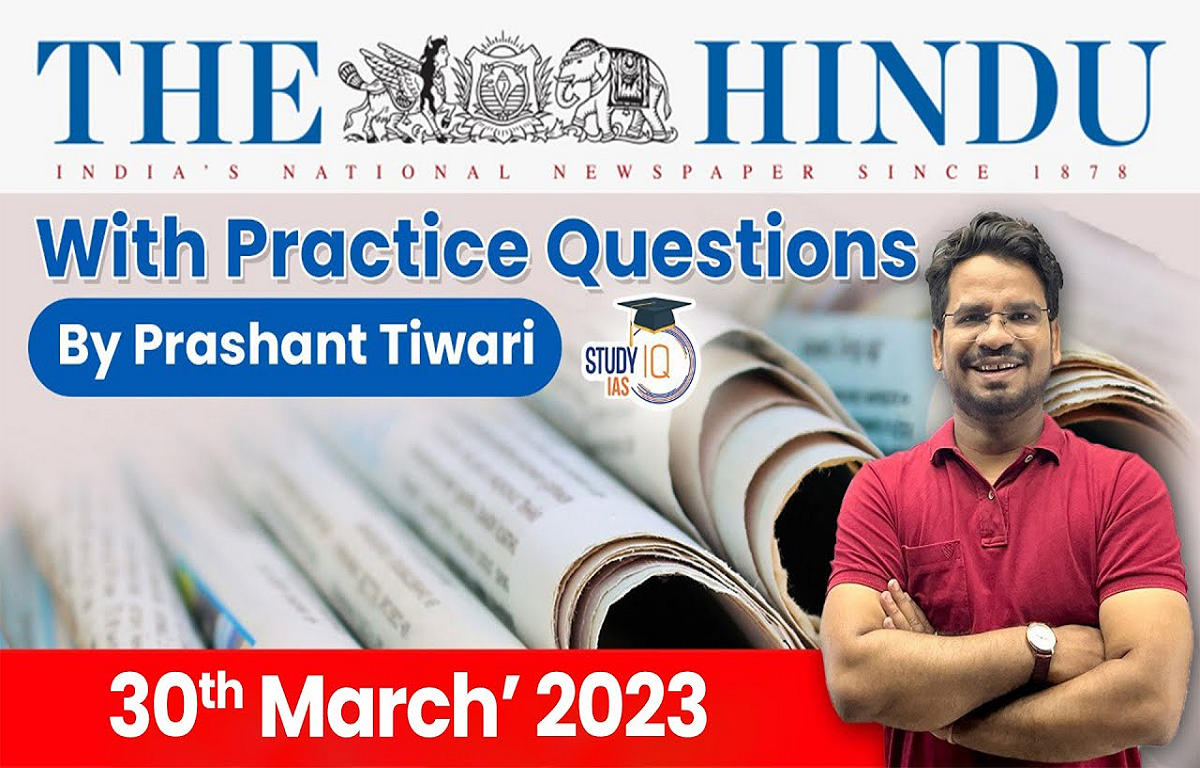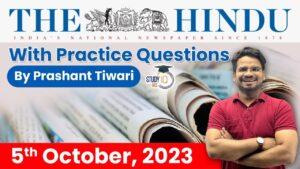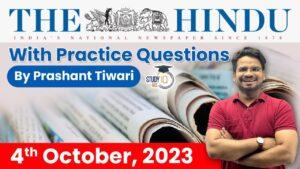The Hindu Newspaper Analysis for UPSC

The Hindu Newspaper Analysis 29 March 2023

- Aadhaar holders can voluntarily use their Aadhaar for private sector purposes, and private sector entities need not seek special permission for such usage. Also, between government departments (intra- and inter-State) Aadhaar data can be shared, but with the prior informed consent of the citizen.
- The United States CLEAR programme (an expedited airport security/airport identity verification process) is now active at 51 airports with about 15 million members at a cost of $369 per annum for a family of four.
- In contrast is a slightly different variant, the DigiYatra, which is totally free of cost for the Indian traveller. Digi Yatra is a Biometric Enabled Seamless Travel (BEST) experience based on a facial recognition system (FRS), again through a partnership between industry and government, which ensures seamless identification of passengers at key check points such as airport entry, security check and boarding gate clearance.
- Take DigiLocker, one of the least known DPIs, which today has 150 million users, six billion stored documents, and done with a tiny budget of ₹50 crore over seven years.
- Let us consider just one more metric, namely, the unified payment interface or UPI which is breaking records under the visionary leadership at the National Payments Corporation of India. It has now crossed eight billion transactions per month and transacts a value of $180 billion a month, or about a staggering 65% of India’s GDP per annum.
- India’s DPI marks our second war for independence — economic freedom from the day-to-day drudgery of life and transactions, which has made it become our new business backbone that is powering India towards a $25 trillion economy by the 100th year of our political independence.

- Since 1960, the government’s approach, be it central or State government, to strikes by their employees has been to invoke ESMA, or the Essential Services Maintenance Act.
- The International Labour Organization is the global organisation universally regarded to be the authoritative and legitimate body that can answer issues in connection with labour. The ILO’s supervisory institution, the Committee on Freedom of Association (the Committee), among others, constructed the principles on the right to strike; this is worth noting as they serve as the guidepost to assess the government’s actions.
- According to the Committee, employees in essential services do not enjoy the right to strike. Essential services are those where “the interruption of which would endanger the life, personal safety or health of the whole or part of the population” (ILO).
About ESMA, 1968:
- The Essential Services Maintenance Act (ESMA) is an act of Parliament of India.
- Objective: It was established to ensure the delivery of certain services, which if obstructed would affect the normal life of the people.
- These include services like public transport (bus services), health services (doctors and hospitals).
- ESMA gives police right to arrest without a warrant anybody violating the Act’s provisions.
- Implementation:
- The ESMA is a law made by the Parliament of India under List No. 33 in Concurrent List of 7th Schedule of Constitution of India.
- Although it is a very powerful law, its execution rests entirely on the discretion of the State government. Each state in the union of India, hence has a separate state Essential Services Maintenance Act with slight variations from the central law in its provisions. This freedom is accorded by the central law itself.
- The Right to protest peacefully is enshrined in the Indian Constitution—Article 19(1)(a) guarantees the freedom of speech and expression; Article 19(1)(b) assures citizens the right to assemble peaceably and without arms.
- Article 19(2) imposes reasonable restrictions on the right to assemble peaceably and without arms.
- These reasonable restrictions are imposed in the interests of the sovereignty and integrity of India, the security of the State, friendly relations with foreign States, public order, decency or morality or in relation to contempt of court, defamation or incitement to an offence.
- In India, the right to protest is a fundamental right under Article 19 of the Constitution of India.
- But right to strike is not a fundamental right but a legal right and with this right statutory restriction is attached in the Industrial Dispute Act, 1947.
- The Industrial Dispute Act, 1947 is subsumed under The Industrial Relations Code, 2020.

- The Right to Health is in sync with the constitutional guarantee of right to life, and other components of the Directive Principles. That no person seeking health care should be denied it, on the grounds of access and affordability, is an acceptable proviso. The Rajasthan Right to Health Act, 2022, addresses these key issues of access and affordability.
- It “seeks to provide protection and fulfilment of rights, equity in relation to health and well-being for achieving the goal of health care for all through guaranteed access to quality health care for all residents of the State, without any catastrophic out-of-pocket expenditure”.
- The law, which also provides for a social audit and grievance redress, gives every resident of the State the right to emergency treatment without paying a single paisa to any health-care institution, and specifies that private health-care institutions would be compensated for the charges incurred for such treatment.
Why are the doctors protesting?
- The protesters claim that the Bill doesn’t help patients much, but penalises doctors and hospitals.
- The most contentious section of the Bill mandates that all hospitals — both public and private — must offer emergency treatment without any prepayment, when required.


- Russian President Vladimir Putin announced last Saturday that Russia plans to station tactical nuclear weapons in Belarus.
- Russia claims that the positioning of tactical nuclear weapons in Belarus by Russia does not violate any international agreements that Moscow has signed because the control over the weapons would remain with Russia just as the U.S. retains control over its nuclear weapons on its allies’ territories.
- Belarus has developed close military and political ties with Russia. It is one of the closest and few remaining allies of Russia. It is predominantly Orthodox like Russia with its population almost entirely-Russian speaking.
- Belarus’ geo-strategic position, between Russia and Ukraine and between Russia and Poland, makes it very important for Russia. It also shares borders with three NATO members — Lithuania, Latvia, and Poland.

What is PV waste?
- Globally, India has the world’s fourth highest solar PV deployment. The installed solar capacity was nearly 62GW in November 2022. This augurs a colossal amount of solar PV waste. According to a 2016 report by the International Renewable Energy Agency, India could generate 50,000-3,25,000 tonnes of PV waste by 2030 and more than four million tonnes by 2050.
- India’s solar PV installations are dominated by crystalline silicon (c-Si) technology. A typical PV panel is made of c-Si modules (93%) and cadmium telluride thin-film modules (7%). A c-Si module mainly consists of a glass sheet, an aluminium frame, an encapsulant, a backsheet, copper wires, and silicon wafers. Silver, tin, and lead are used to make c-Si modules. The thin-film module is made of glass, encapsulant, and compound semiconductors.
Is this waste recovered or recycled?
- As these panels near expiration, some portions of the frame are extracted and sold as scrap; junctions and cables are recycled according to e-waste guidelines; the glass laminate is partly recycled; and the rest is disposed of as general waste. Silicon and silver can be extracted by burning the module in cement furnaces.
- According to a 2021 report, approximately 50% of the total materials can be recovered. India’s challenge is the growing informal handling of PV waste. Only about 20% of the waste is recovered in general; the rest is treated informally.
- As a result, the waste often accumulates at landfills, which pollute the surroundings. Incinerating the encapsulant also releases sulphur dioxide, hydrogen fluoride, and hydrogen cyanide into the atmosphere.
- India needs to surmount significant collection, storage, recycling, and repurposing challenges. The market to repurpose or reuse recycled PV waste is minuscule in India due to a lack of suitable incentives and schemes in which businesses can invest.


 The Hindu Newspaper Analysis 6 October 2...
The Hindu Newspaper Analysis 6 October 2...
 The Hindu Newspaper Analysis 5 October 2...
The Hindu Newspaper Analysis 5 October 2...
 The Hindu Newspaper Analysis 4 October 2...
The Hindu Newspaper Analysis 4 October 2...

















